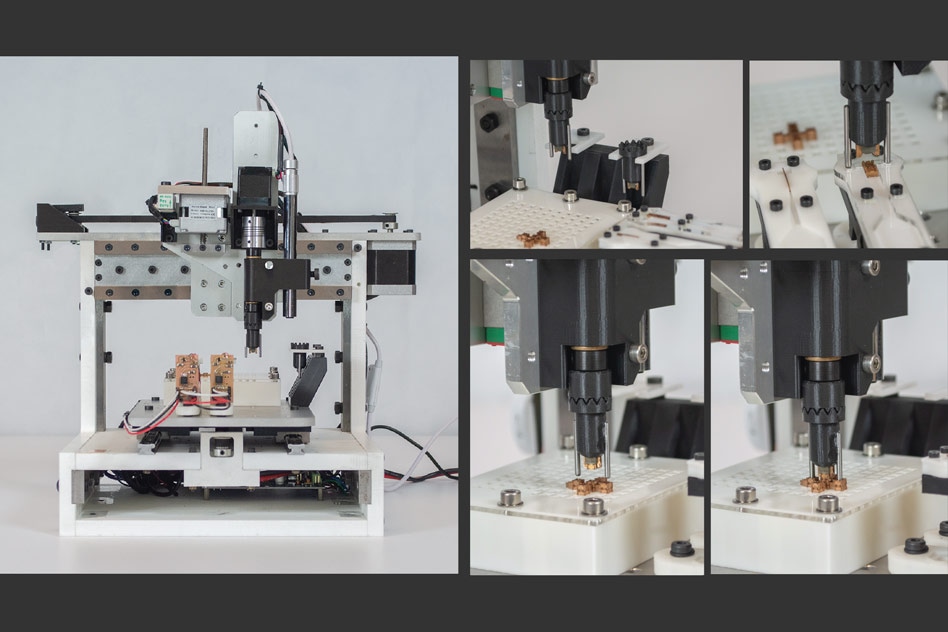Jul 3 2019
Neil Gershenfeld, a professor at MIT, came up with an audacious idea years ago. Considering the fact that all the living things in the world are made out of combinations of only 20 amino acids, he wondered whether it would be feasible to develop a kit that contains only 20 basic parts which can then be used for assembling all the world’s different technological products.
 MIT graduate student Will Langford developed a machine that's like a cross between a 3-D printer and the pick-and-place machines that manufacture electronic circuits, but that can produce complete robotic systems directly from digital designs (video in Related sidebar below shows the assembly of a machine from five standard parts). (Image credit: Will Langford).
MIT graduate student Will Langford developed a machine that's like a cross between a 3-D printer and the pick-and-place machines that manufacture electronic circuits, but that can produce complete robotic systems directly from digital designs (video in Related sidebar below shows the assembly of a machine from five standard parts). (Image credit: Will Langford).
Since then, Gershenfeld and his students have been steadily working in that direction. Their breakthrough achievement was recently presented at an international robotics conference. It comprises a set of five small basic complements that can be arranged into many different functional devices, such as a small “walking” motor that can turn the gears of a machine, or move to and fro across a surface.
Earlier, Gershenfeld and his students demonstrated that various mechanical properties can be exhibited by structures that were assembled from numerous tiny and identical subunits. The team subsequently showed that a combination of flexible and rigid part types can be used for morphing airplane wings, a longstanding objective in aerospace engineering.
The researchers’ recent work adds components for logic and movement, and this will be presented at the International Conference on Manipulation, Automation and Robotics at Small Scales (MARSS) which will be held in Helsinki, Finland, in a paper written by Gershenfeld and Will Langford, a graduate student at MIT.
The team’s work provides an alternative to present-day techniques for building robots, which mostly fall into one of two types—reconfigurable machines that sacrifice performance for versatility, and custom machines that work suitably but are not flexible and also more costly.
In the latest method, Langford created a set of five millimeter-scale parts, which can be collectively connected to one another by a typical connector. These components include the earlier flexible and rigid types, together with electromagnetic parts, a magnet, and a coil. In the coming days, the researchers are planning to make these from still smaller fundamental parts.
Langford used this basic kit of small parts and arranged them into a new type of motor that moves an appendage in distinct mechanical steps, which can then be utilized for turning a gear wheel, and also moves the motor’s mobile form that changes those steps into locomotion. This enables it to “walk” across a surface in a manner that is indicative of the molecular motors that shift muscles.
In addition, such kinds of components could be assembled into legs for walking or hands for gripping, as required for a specific task, and then subsequently reassembled as those requirements change. Gershenfeld has dubbed them as “digital materials”—distinct parts that can be reversibly connected, creating a kind of functional micro-LEGO.
The novel system is a major step toward producing a standardized kit of parts that can perhaps be used for assembling robots with certain capabilities suited to a specific task or series of tasks. Purpose-built robots like that can be subsequently disassembled and reassembled as required in many different forms, without having to design and create new kinds of robots from scratch for every specific application.
The initial motor developed by Langford has an ant-like capacity to lift around seven times its own weight. However, if greater forces are needed, then most of these parts can be added to give more dynamism. In case, the robot has to be moved in more intricate ways, these components can be distributed across the structure. It is possible to select the size of the building blocks to match their application; the researchers have made meter-sized parts to make megarobots, and nanometer-sized parts to make nanorobots. Earlier, unique methods were required at each of these length scale extremes.
One emerging application is to make tiny robots that can work in confined spaces.
Neil Gershenfeld, Professor, MIT
For example, some of the devices assembled in this project are smaller than a penny, but can still perform many useful tasks.
Langford has added part types to build in the “brains”. These parts contain millimeter-sized integrated circuits, together with several other part types to take care of joining electrical signals in three dimensions.
The regularity and simplicity of these structures make it much easier to automate their assembly. In order to achieve that, Langford has created an innovative machine that is like a cross between pick-and-place machines and a 3D printer; the machines manufacture electronic circuits. However, unlike either of those, Langford’s machine can create complete robotic systems straight from digital designs.
According to Gershenfeld, this machine is an initial step toward the project’s ultimate objective of “making an assembler that can assemble itself out of the parts that it's assembling.”
Standardization is an extremely important issue in microrobotics, to reduce the production costs and, as a result, to improve acceptance of this technology to the level of regular industrial robots.
Sergej Fatikow, Head of the Division of Microrobotics and Control Engineering, University of Oldenburg, Germany
Fatikow was not associated with this study.
The latest work “addresses assembling of sophisticated microrobotic systems from a small set of standard building blocks, which may revolutionize the field of microrobotics and open up numerous applications at small scales,” he concluded.